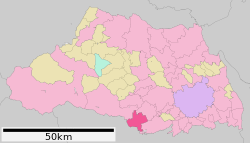Iruma, Saitama
|
Iruma 入間市 |
|||
|---|---|---|---|
| City | |||

Iruma City Hall
|
|||
|
|||
 Location of Iruma in Saitama Prefecture |
|||
| Location of Iruma in Saitama Prefecture | |||
| Coordinates: 35°50′8.9″N 139°23′28.1″E / 35.835806°N 139.391139°ECoordinates: 35°50′8.9″N 139°23′28.1″E / 35.835806°N 139.391139°E | |||
| Country | Japan | ||
| Region | Kantō | ||
| Prefecture | Saitama Prefecture | ||
| Area | |||
| • Total | 44.69 km2 (17.25 sq mi) | ||
| Population (February 2016) | |||
| • Total | 148,460 | ||
| • Density | 3,320/km2 (8,600/sq mi) | ||
| Time zone | Japan Standard Time (UTC+9) | ||
| - Tree | Zelkova serrata | ||
| - Flower | Camellia sinensis | ||
| - Bird | Eurasian skylark | ||
| Phone number | 04-2964-1111 | ||
| Address | 1-16-1toyooka, Iruma-shi, Saitama-ken 358-8511 | ||
| Website | Official website | ||
Iruma (入間市 Iruma-shi?) is a city located in Saitama Prefecture, in the central Kantō region of Japan. As of 1 February 2016[update], the city had an estimated population of 148,460 and a population density of 3,320 persons per km². Its total area was 44.69 square kilometres (17.25 sq mi).
Located in the Satama Highlands of far southern Saitama Prefecture, Iruma is bordered by Tokyo to the south. The Iruma River flows through the city.
Iruma developed as a series of three post towns on the Nikkō Wakiōkan highway during the Edo period. The town of Toyooka and villages of Kaneko, Miyadera, Fujisawa and Higashikaneko were created within Iruma District, Saitama with the establishment of the municipalities system on April 1, 1889. The Imperial Japanese Army Air Academy established an airfield in the area in 1938, which later developed into Iruma Air Base. On April 1, 1954 Higashikaneko became Seibu Town. On September 30, 1956, Toyooka, Kaneko, Miyadera, Fujisawa and Seibu merged to form the town of Musashi. Musashi was elevated to city status on November 1, 1966, becoming the city of Iruma.
Iruma has a mixed economy with numerous industrial parks for light manufacturing and also serves as a regional commercial center. Due to its location, it is also a bedroom community for people commuting to the Tokyo metropolis for work. In terms of agriculture, Iruma and neighboring Sayama are famous for the green tea they produce.
...
Wikipedia



